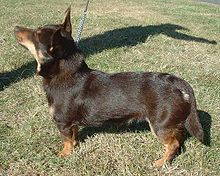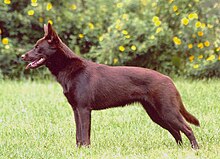
Originating from the lush landscapes of Lancashire, England, the Lancashire Heeler stands as a charismatic blend of herding prowess and compact agility. Historically employed to drive cattle by nipping at their heels, this small but tenacious breed is characterized by its black and tan coat, alert expression, and spirited nature. While their numbers were once dwindling, enthusiasts of the breed have championed its revival, celebrating the Heeler’s dual role as a working dog and a loving family companion.
The Lancashire Heeler is a member of the AKC Herding Group.
Breed Characteristics
| Dog Breed | Lancashire Heeler |
| Breed Popularity (AKC) | |
| Country of Origin | England |
| Personality | Friendly |
| Life Expectancy | 12-15 yrs |
| Height | 10-12 in |
| Weight | 9-17 lbs |
| Color | Black & Tan, Liver & Tan |
| Coat | Short, double |
| Shedding | Seasonal |
| Grooming | Occasional Bath/Brush |
| Health Problems | Primary Lens Luxation |
| Trainability | Easy Training |
| Exercise Needs | Energetic |
Lancashire Heeler History
Originating from the UK, the Lancashire Heeler was initially bred for herding and driving cattle. Its ancestry is believed to be a mix between the Welsh Corgi and a type of small black-and-tan terrier. Though small in stature, the Lancashire Heeler is robust and energetic, making it an excellent working dog and companion.
Temperament
The Lancashire Heeler is a small breed with a big heart. Originally bred for herding, their behavior is active and alert. They possess both intelligence and agility, and while they have a moderate to high energy level, they’re also content to relax with their family. Their trainability is high, but early socialization is crucial to ensure they’re well-rounded. Their barking tendencies are moderate, primarily when they’re alert or herding.
Remember, while breed traits provide a general idea, individual dogs can have personalities that differ from the breed standard. Always spend time getting to know the dog and ensure their needs and temperament align with your lifestyle.
Grooming Requirements
The Lancashire Heeler has a short, dense coat that’s easy to maintain. Regular brushing and the use of a suitable dog shampoo during baths will keep the coat shining. Other grooming essentials, like nail trimming and ear cleaning, are also vital for this breed.
Lancashire Heeler Health
Lancashire Heelers, living around 12-15 years, might be predisposed to issues like Primary Lens Luxation. It’s essential to maintain a consistent schedule for vaccinations, deworming, and flea prevention. Offering a balanced diet and being cautious about potential allergies, particularly with new dog food or treats, supports their health.
Exercise Needs
The Lancashire Heeler is an active and alert breed, originally used for herding. Regular walks and mental stimulation through games like fetch and agility are essential. Visits to the dog park can allow them to socialize and play, but it’s crucial to monitor their herding instincts around other pets.
Training
With roots in England, the Lancashire Heeler is a herding and driving dog, energetic and alert. Obedience training leverages their natural instincts, and clear commands aid in their potty training. Crate training offers them a personal retreat, while behavior problems like nipping need careful attention. Socialization is key to help them differentiate between herding and play.
Lancashire Heeler Pictures
Related Dog Breeds
More Dog Resources
Are you thinking about getting a puppy? Make sure to check out our list of important questions to ask before you adopt a puppy.
We also have many resources to help, from naming your puppy to socialization resources and training tips.
Take me back to the Ultimate Guide to Dog Breeds



